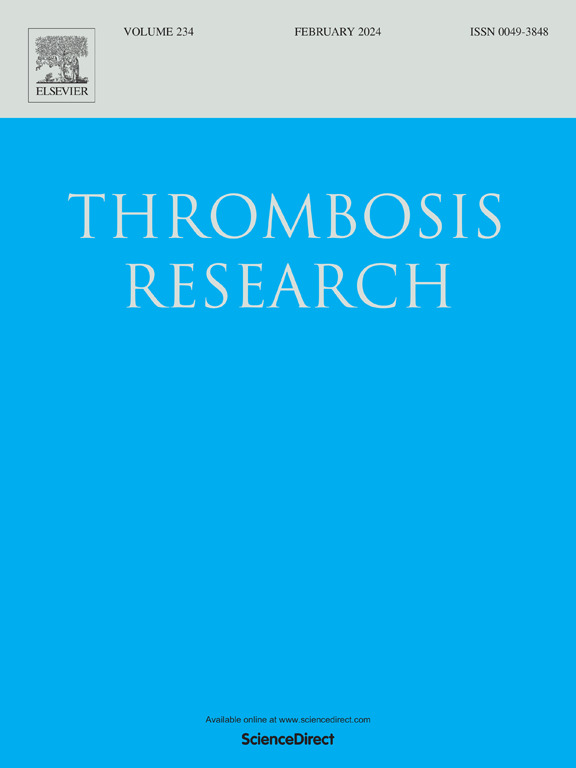Evaluating strategies for preventing splanchnic vein thrombosis after splenectomy in cirrhosis: Evidence from published trials and retrospective cohort data
IF 3.4
3区 医学
Q1 HEMATOLOGY
引用次数: 0
Abstract
Background
Splanchnic vein thrombosis (SVT) is a common complication following splenectomy in cirrhotic patients, yet the optimal prophylactic antithrombotic regimen remains unclear. This study combines data from published trials with our institutions to assess the efficacy of various strategies.
Methods
We systematically searched five English and Chinese databases from inception to October 2024 for randomized controlled trials (RCTs) and cohort studies focused on SVT prevention after splenectomy, then conducting a network comparison to evaluate SVT incidence across different prophylactic regimens. Additionally, a retrospective dual-center cohort study was conducted to explore the diversity and effectiveness of prevention strategies in clinical practice.
Results
The network comparison included four RCTs and two cohort studies (n = 429), showed that rivaroxaban ± aspirin significantly reduced SVT incidence from postoperative month (POM) 1 to 6 compared to warfarin + low-molecular-weight heparin (LMWH) + aspirin/dipyridamole (POM 3: relative risk [RR] 0.36, 95 % confidence interval [CI] 0.14–0.88, P = 0.03) and aspirin + LMWH + dipyridamole (POM 3: RR 0.12, 95 % CI 0.05–0.32, P < 0.001), respectively. However, the efficacy of rivaroxaban was reported in only one of the four RCTs, limits its robustness. Conversely, our retrospective cohort study (six interventions: no antithrombotic, LMWH, aspirin, rivaroxaban, warfarin + LMWH + aspirin, and rivaroxaban + aspirin, n = 281) revealed no superiority of one strategy over others.
Conclusions
Strategies to prevent SVT post-splenectomy in cirrhosis vary widely, with no consensus on the best approach. Larger, well-designed RCTs are needed to determine the effectiveness of prophylaxis.

肝硬化脾切除术后预防内脏静脉血栓形成的评估策略:来自已发表试验和回顾性队列数据的证据
背景:脾静脉血栓形成(SVT)是肝硬化患者脾切除术后常见的并发症,但最佳的预防抗血栓方案尚不清楚。本研究结合已发表的试验数据和我们的机构来评估各种策略的有效性。方法系统检索5个中英文数据库,从建立之日起至2024年10月,检索集中于脾切除术后SVT预防的随机对照试验(rct)和队列研究,然后进行网络比较,评估不同预防方案下SVT的发生率。此外,我们还进行了一项回顾性双中心队列研究,以探讨临床实践中预防策略的多样性和有效性。结果网络比较包括4项随机对照试验和2项队列研究(n = 429),结果显示,与华法林+低分子肝素(LMWH) +阿司匹林/双嘧达莫(POM 3:相对危险度[RR] 0.36, 95%可信区间[CI] 0.14-0.88, P = 0.03)和阿司匹林+低分子肝素+双嘧达莫(POM 3: RR 0.12, 95% CI 0.05-0.32, P <;分别为0.001)。然而,利伐沙班的疗效仅在四项随机对照试验中有一项报道,限制了其稳健性。相反,我们的回顾性队列研究(六项干预措施:无抗栓药物、低分子肝素、阿司匹林、利伐沙班、华法林+低分子肝素+阿司匹林和利伐沙班+阿司匹林,n = 281)显示没有一种策略优于其他策略。结论肝硬化脾切除术后预防SVT的策略差异很大,最佳方法尚无共识。需要更大规模、设计良好的随机对照试验来确定预防的有效性。
本文章由计算机程序翻译,如有差异,请以英文原文为准。
求助全文
约1分钟内获得全文
求助全文
来源期刊

Thrombosis research
医学-外周血管病
CiteScore
14.60
自引率
4.00%
发文量
364
审稿时长
31 days
期刊介绍:
Thrombosis Research is an international journal dedicated to the swift dissemination of new information on thrombosis, hemostasis, and vascular biology, aimed at advancing both science and clinical care. The journal publishes peer-reviewed original research, reviews, editorials, opinions, and critiques, covering both basic and clinical studies. Priority is given to research that promises novel approaches in the diagnosis, therapy, prognosis, and prevention of thrombotic and hemorrhagic diseases.
 求助内容:
求助内容: 应助结果提醒方式:
应助结果提醒方式:


